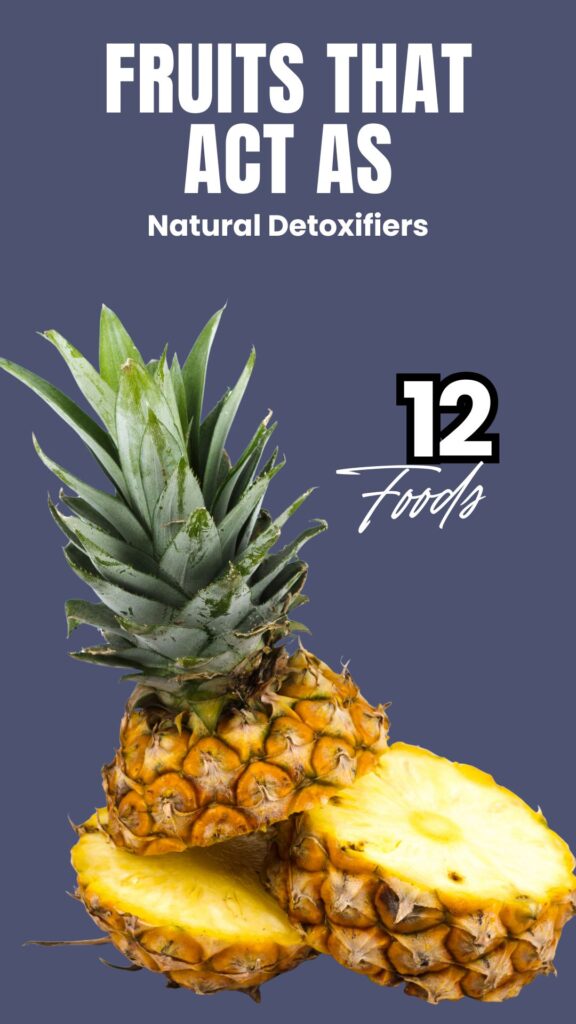Some links in this post are affiliate links. If you make a purchase through these links, I may receive a small commission. This helps support the site at no extra cost to you.
Struggling with low energy, bloating, or skin issues? Did you know that what you eat can directly influence how your body naturally detoxifies itself?
While your liver and kidneys do a fantastic job at cleansing your body, certain fruits can act as natural detoxifiers, supporting these organs and boosting overall well-being.
In this post, we’ll explore 12 powerful fruits that help flush out toxins, improve digestion, enhance immunity, and even support weight management. Along the way, you’ll learn the best ways to consume them, who should include or avoid them, and tips to maximize their benefits.
By the end, you’ll have a handy guide to incorporate these fruits into your daily routine—without feeling like you’re on a strict detox diet.

Table of Contents

12 Best Fruits That Are Natural Detoxifiers
1. Lemon
Best Ways to Eat or Use It
- Squeeze fresh lemon juice in warm water in the morning.
- Add to salads, fish, or herbal teas.
- Use as a flavor enhancer for smoothies.
Tip: Pair lemon with honey or a small amount of healthy fat like avocado to improve vitamin C absorption.
Who Should Eat / Avoid
Good for: People with sluggish digestion, those needing a vitamin C boost, and those aiming for better skin health.
Avoid/Limit if: You have acid reflux, ulcers, or citrus allergies.
Storage & Buying Tips
- Choose firm lemons with bright, glossy skin.
- Store at room temperature for up to a week, or refrigerate for longer freshness.
Do’s & Don’ts
| ✅ Do | ❌ Don’t |
|---|---|
| Drink lemon water first thing in the morning | Rely solely on lemon for detox |
| Use fresh juice over bottled | Consume excessively on empty stomach |
Possible Side Effects
Excess lemon juice may erode tooth enamel if consumed too frequently; rinse mouth with water afterward.
2. Apple
Best Ways to Eat or Use It
- Raw as a snack.
- Sliced in oatmeal or yogurt bowls.
- Baked with cinnamon for a healthy dessert.
Tip: Eat the skin for fiber and polyphenols that support liver detoxification.
Who Should Eat / Avoid
Good for: Weight-loss seekers, people with digestive issues, and anyone looking to lower cholesterol naturally.
Avoid/Limit if: You have irritable bowel syndrome (IBS) and notice discomfort from high-fiber fruits.
Storage & Buying Tips
- Choose firm, blemish-free apples.
- Refrigerate to extend shelf life for 2–4 weeks.
Do’s & Don’ts
| ✅ Do | ❌ Don’t |
|---|---|
| Eat with skin for fiber | Leave cut apples exposed to air too long |
| Combine with nut butter for satiety | Overconsume if diabetic |
Possible Side Effects
Too many apples may cause bloating due to fiber content.
3. Blueberries
Best Ways to Eat or Use It
- Fresh or frozen in smoothies.
- Mixed into yogurt or cereals.
- As a topping on salads for a sweet, tangy twist.
Tip: Pair with a source of fat like almonds or yogurt to enhance antioxidant absorption.
Who Should Eat / Avoid
Good for: Athletes, older adults, and anyone wanting to reduce oxidative stress.
Avoid/Limit if: Rarely, people with blueberry allergies.
Storage & Buying Tips
- Select plump, deep-colored berries.
- Refrigerate in breathable containers; freeze for longer storage.
Do’s & Don’ts
| ✅ Do | ❌ Don’t |
|---|---|
| Rinse before eating | Soak in water for long periods |
| Mix with other fruits for antioxidants | Add too much sugar |
Possible Side Effects
Excessive consumption may cause mild stomach upset.
4. Pineapple
Best Ways to Eat or Use It
- Fresh slices or chunks.
- Smoothies, juices, or salads.
- Grilled as a dessert or side dish.
Tip: Bromelain in pineapple aids digestion and reduces inflammation—perfect after a heavy meal.
Who Should Eat / Avoid
Good for: People with digestive issues, inflammation, or sore muscles.
Avoid/Limit if: You have mouth ulcers or are allergic to bromelain.
Storage & Buying Tips
- Look for a sweet aroma and golden color.
- Store at room temperature until ripe; refrigerate afterward.
Do’s & Don’ts
| ✅ Do | ❌ Don’t |
|---|---|
| Eat fresh for maximum enzymes | Use canned pineapple with added sugar |
| Combine with protein for better digestion | Overconsume and irritate the mouth |
Possible Side Effects
High amounts may cause temporary mouth irritation or heartburn.
5. Watermelon
Best Ways to Eat or Use It
- Fresh chunks as a hydrating snack.
- Smoothies or cold soups.
- Add to fruit salads with mint.
Tip: Its high water content helps flush toxins and supports kidney function.
Who Should Eat / Avoid
Good for: Those needing hydration, athletes, and weight watchers.
Avoid/Limit if: You have blood sugar concerns; watermelon is high in natural sugars.
Storage & Buying Tips
- Choose firm, uniform color with a yellow spot on the underside (ripe).
- Store cut watermelon in the refrigerator for up to 3 days.
Do’s & Don’ts
| ✅ Do | ❌ Don’t |
|---|---|
| Consume fresh for hydration | Leave cut watermelon out too long |
| Pair with protein for balanced meals | Overeat if diabetic |
Possible Side Effects
Excessive intake may increase sugar intake and cause mild digestive discomfort.
6. Pomegranate
Best Ways to Eat or Use It
- Seeds in salads, oatmeal, or yogurt.
- Juice (freshly squeezed) in smoothies.
- Sprinkle over desserts for tangy flavor.
Tip: Eating seeds provides fiber and polyphenols, enhancing liver detoxification.
Who Should Eat / Avoid
Good for: People looking to improve heart health, athletes, and anyone needing antioxidants.
Avoid/Limit if: You have digestive sensitivity to high-fiber seeds.
Storage & Buying Tips
- Choose heavy, unblemished fruits.
- Store in a cool, dry place or refrigerate for up to a month.
Do’s & Don’ts
| ✅ Do | ❌ Don’t |
|---|---|
| Drink juice immediately | Store juice for too long |
| Eat seeds for fiber | Overconsume pomegranate in large quantities |
Possible Side Effects
Large amounts may interact with some medications or cause mild diarrhea.
7. Grapefruit
Best Ways to Eat or Use It
- Halved with a spoon for breakfast.
- Juice (unsweetened) in smoothies.
- Zest for flavoring dishes.
Tip: Pair with protein for balanced blood sugar.
Who Should Eat / Avoid
Good for: Weight management, immune support, and liver detox.
Avoid/Limit if: On certain medications (like statins) due to grapefruit interactions.
Storage & Buying Tips
- Choose firm, heavy grapefruits with vibrant skin.
- Store at room temperature for up to a week; refrigerate to extend shelf life.
Do’s & Don’ts
| ✅ Do | ❌ Don’t |
|---|---|
| Eat fresh to maximize vitamin C | Consume with incompatible medications |
| Pair with protein or healthy fats | Rely solely on grapefruit for detox |
Possible Side Effects
May interact with medications; consult your doctor if unsure.
8. Kiwi
Best Ways to Eat or Use It
- Sliced raw in fruit salads.
- Smoothies or yogurt bowls.
- Kiwi-based salsas with mint and lime.
Tip: Eat with a little fat (like yogurt) for better vitamin absorption.
Who Should Eat / Avoid
Good for: Immune support, digestion, and skin health.
Avoid/Limit if: Allergic to latex or certain enzymes in kiwi.
Storage & Buying Tips
- Choose firm, fragrant fruits.
- Store at room temperature until ripe; refrigerate for longer freshness.
Do’s & Don’ts
| ✅ Do | ❌ Don’t |
|---|---|
| Eat with skin if possible | Overconsume if allergic |
| Combine with other fruits | Store for too long before eating |
Possible Side Effects
Some people may experience oral irritation or allergic reactions.
9. Papaya
Best Ways to Eat or Use It
- Raw chunks or in smoothies.
- Papaya salad or salsas.
- Use in desserts or baked dishes.
Tip: Papain enzyme aids digestion and reduces inflammation.
Who Should Eat / Avoid
Good for: Digestive issues, skin health, and immune support.
Avoid/Limit if: Pregnant women should consult regarding unripe papaya.
Storage & Buying Tips
- Choose slightly soft, aromatic papayas.
- Store at room temperature to ripen; refrigerate once ripe.
Do’s & Don’ts
| ✅ Do | ❌ Don’t |
|---|---|
| Eat ripe for best benefits | Use unripe papaya without guidance |
| Combine with citrus for vitamin boost | Overconsume for digestion issues |
Possible Side Effects
Excessive intake may cause mild laxative effects.
10. Grapes
Best Ways to Eat or Use It
- Raw as snacks.
- Frozen for chilled treats.
- Juice or add to salads.
Tip: Red and black grapes contain resveratrol, supporting liver detoxification.
Who Should Eat / Avoid
Good for: Heart health, liver function, and immunity.
Avoid/Limit if: Diabetic or sensitive to sugar.
Storage & Buying Tips
- Choose plump, firm grapes.
- Store in the refrigerator in breathable bags; wash before eating.
Do’s & Don’ts
| ✅ Do | ❌ Don’t |
|---|---|
| Eat with skin for antioxidants | Overconsume grapes for sugar |
| Freeze for refreshing snack | Leave unrefrigerated for long periods |
Possible Side Effects
Excessive consumption may increase blood sugar and digestive issues.
11. Orange
Best Ways to Eat or Use It
- Eat fresh segments.
- Juice (freshly squeezed).
- Add zest to desserts, salads, and marinades.
Tip: Pair with healthy fats to increase vitamin absorption.
Who Should Eat / Avoid
Good for: Immunity, skin health, and liver detox.
Avoid/Limit if: Allergic to citrus.
Storage & Buying Tips
- Firm, bright-colored fruits are best.
- Refrigerate to extend shelf life; consume fresh.
Do’s & Don’ts
| ✅ Do | ❌ Don’t |
|---|---|
| Eat fresh for maximum vitamin C | Rely solely on orange for detox |
| Pair with protein or healthy fats | Juice excessively with added sugar |
Possible Side Effects
May aggravate acid reflux in sensitive individuals.
12. Avocado
Best Ways to Eat or Use It
- Sliced in salads or sandwiches.
- Mashed as guacamole or toast topping.
- Smoothies for creamy texture.
Tip: Healthy fats help absorb fat-soluble vitamins from other detoxifying foods.
Who Should Eat / Avoid
Good for: Heart health, weight management, and nutrient absorption.
Avoid/Limit if: Allergic to avocados or on potassium-restricted diets.
Storage & Buying Tips
- Choose slightly soft, firm fruits.
- Store unripe at room temperature; refrigerate once ripe.
Do’s & Don’ts
| ✅ Do | ❌ Don’t |
|---|---|
| Pair with other fruits for nutrient absorption | Overconsume due to high-calorie content |
| Use in salads, smoothies, or toast | Rely solely on avocado for detox |
Possible Side Effects
Excessive intake may contribute to weight gain due to high calories.
Conclusion
Incorporating these 12 fruits into your daily diet can support natural detoxification, boost immunity, improve digestion, and enhance overall vitality.
From the tangy kick of lemon to the creamy goodness of avocado, each fruit brings unique benefits to your body’s cleansing systems.
Start small: try adding one or two of these fruits to your meals daily and notice the positive changes. Experiment with smoothies, salads, or simple snacks, and make detoxifying fruits a delicious part of your routine.
Frequently Asked Questions (FAQs)
What are natural detoxifying fruits?
Natural detoxifying fruits are fruits that help your body eliminate toxins, improve digestion, boost liver function, and support overall health. They often contain antioxidants, fiber, and vitamins that aid detoxification.
How do fruits help detox the body?
Fruits are rich in vitamins, minerals, antioxidants, and fiber, which support the liver, kidneys, and digestive system. These nutrients help flush out toxins, reduce oxidative stress, and improve metabolism.
Can I eat these fruits every day for detox?
Yes, incorporating a variety of these fruits daily is beneficial. However, balance is key—overconsumption, especially of high-sugar fruits like grapes or watermelon, may not be suitable for everyone.
Do detox fruits help with weight loss?
Yes. Many detoxifying fruits are low in calories and high in fiber, which helps with satiety and supports healthy digestion, indirectly aiding weight management.
Are these fruits safe for pregnant women?
Most of these fruits are safe for pregnant women in moderation. However, consult a doctor before consuming fruits like papaya, especially unripe papaya, due to potential uterine stimulation.
Can children eat detox fruits?
Yes. Most detox fruits are safe and nutritious for children, providing essential vitamins and antioxidants. Introduce them gradually, and avoid citrus or berries if a child has allergies.
Are frozen fruits as good as fresh fruits for detox?
Frozen fruits retain most of their nutrients if properly stored. While fresh fruits are ideal, frozen options are convenient and still effective for detox purposes.
How should I combine these fruits for best detox benefits?
Combine high-fiber fruits with healthy fats (e.g., avocado with berries) or pair vitamin C-rich fruits (like lemon or orange) with iron-rich foods for better nutrient absorption.
Can I use these fruits in smoothies?
Absolutely. Smoothies are a great way to enjoy multiple detox fruits at once. Blend them with water, yogurt, or a small amount of healthy fat to maximize nutrient absorption.
Are there any side effects of detox fruits?
Most detox fruits are safe when eaten in moderation. Overconsumption may cause bloating, digestive discomfort, or, in rare cases, allergic reactions, depending on the fruit.










